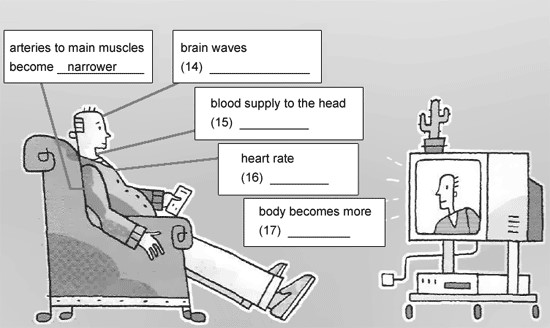دومین بخش تست آیلتس را ریدینگ به خود اختصاص داده است. ریدینگ آیلتس معمولا ۳ یا ۴ قسمت است که معمولا هریک دشوارتر از قبلی است. یکی از روشهای بسیار مفید برای آشنایی و در مرحلهی بعد تسلط و در نهایت دریافت امتیاز بالا در این بخش، حل نمونه سوالات ریدینگ آیلتس است. در این مقاله تعدادی از نمونه سوالات ریدینگ آیلتس با جواب را برای شما آورده ایم تا بیشتر با آنها آشنا شوید.
IELTS Academic Reading – Passage 1

Light Pollution is a threat to Wildlife, Safety and the Starry Sky
A After hours of driving south in the pitch-black darkness of the Nevada desert, a dome of hazy gold suddenly appears on the horizon. Soon, a road sign confirms the obvious: Las Vegas 30 miles. Looking skyward, you notice that the Big Dipper is harder to find than it was an hour ago.
B Light pollution—the artificial light that illuminates more than its intended target area—has become a problem of increasing concern across the country over the past 15 years. In the suburbs, where over-lit shopping mall parking lots are the norm, only 200 of the Milky Way’s 2,500 stars are visible on a clear night. Even fewer can be seen from large cities. In almost every town, big and small, street lights beam just as much light up and out as they do down, illuminating much more than just the street. Almost 50 percent of the light emanating from street lamps misses its intended target, and billboards, shopping centres, private homes and skyscrapers are similarly over-illuminated.
C America has become so bright that in a satellite image of the United States at night, the outline of the country is visible from its lights alone. The major cities are all there, in bright clusters: New York, Boston, Miami, Houston, Los Angeles, Seattle, Chicago, and, of course, Las Vegas. Mark Adams, superintendent of the McDonald Observatory in west Texas, says that the very fact that city lights are visible from on high is proof of their wastefulness. “When you’re up in an airplane, all that light you see on the ground from the city is wasted. It’s going up into the night sky. That’s why you can see it.”
D But don’t we need all those lights to ensure our safety? The answer from light engineers, light pollution control advocates and astronomers is an emphatic “no.” Elizabeth Alvarez of the International Dark Sky Association (IDA), a non-profit organization in Tucson, Arizona, says that overly bright security lights can actually force neighbours to close the shutters, which means that if any criminal activity does occur on the street, no one will see it. And the old assumption that bright lights deter crime appears to have been a false one: A new Department of Justice report concludes that there is no documented correlation between the level of lighting and the level of crime in an area. And contrary to popular belief, more crimes occur in broad daylight than at night.
E For drivers, light can actually create a safety hazard. Glaring lights can temporarily blind drivers, increasing the likelihood of an accident. To help prevent such accidents, some cities and states prohibit the use of lights that impair night-time vision. For instance, New Hampshire law forbids the use of “any light along a highway so positioned as to blind or dazzle the vision of travellers on the adjacent highway.”
F Badly designed lighting can pose a threat to wildlife as well as people. Newly hatched turtles in Florida move toward beach lights instead of the more muted silver shimmer of the ocean. Migrating birds, confused by lights on skyscrapers, broadcast towers and lighthouses, are injured, sometimes fatally, after colliding with high, lighted structures. And light pollution harms air quality as well: Because most of the country’s power plants are still powered by fossil fuels, more light means more air pollution.
G So what can be done? Tucson, Arizona is taking back the night. The city has one of the best lighting ordinances in the country, and, not coincidentally, the highest concentration of observatories in the world. Kitt Peak National Optical Astronomy Observatory has 24 telescopes aimed skyward around the city’s perimeter, and its cadre of astronomers needs a dark sky to work with.
H For a while, that darkness was threatened. “We were totally losing the night sky,” Jim Singleton of Tucson’s Lighting Committee told Tulsa, Oklahoma’s KOTV last March. Now, after retrofitting inefficient mercury lighting with low-sodium lights that block light from “trespassing” into unwanted areas like bedroom windows, and by doing away with some unnecessary lights altogether, the city is softly glowing rather than brightly beaming. The same thing is happening in a handful of other states, including Texas, which just passed a light pollution bill last summer. “Astronomers can get what they need at the same time that citizens get what they need: safety, security and good visibility at night,” says McDonald Observatory’s Mark Adams, who provided testimony at the hearings for the bill.
I And in the long run, everyone benefits from reduced energy costs. Wasted energy from inefficient lighting costs us between $1 and $2 billion a year, according to IDA. The city of San Diego, which installed new, high-efficiency street lights after passing a light pollution law in 1985, now saves about $3 million a year in energy costs.
J Legislation isn’t the only answer to light pollution problems. Brian Greer, Central Ohio representative for the Ohio Light Pollution Advisory Council, says that education is just as important, if not more so. “There are some special situations where regulation is the only fix,” he says. “But the vast majority of bad lighting is simply the result of not knowing any better.” Simple actions like replacing old bulbs and fixtures with more efficient and better-designed ones can make a big difference in preserving the night sky.
*The Big Dipper: a group of seven bright stars visible in the Northern Hemisphere.
Questions 1-5
The first six paragraphs of Reading Passage 1 are lettered A-F.
Choose the most suitable headings for paragraphs A-F from the list of headings below.
NB There are more headings than paragraphs, so you will not use them all.
List of Headings
I Why lights are needed
Ii Lighting discourages law breakers
Iii The environmental dangers
iv People at risk from bright lights
V Illuminating space
Vi A problem lights do not solve
Vii Seen from above
Viii More light than is necessary
Ix Approaching the city
Example Answer
Paragraph A ix
۱ Paragraph B ……….
۲ Paragraph C ……….
۳ Paragraph D ……….
۴ Paragraph E ……….
۵ Paragraph F ……….
IELTS Tip
For any questions where you need to write words from the passage, a hyphenated word (e.g. long-term) counts as ONE word.
Questions 6-9
Complete each of the following statements with words taken from the passage.
Write ONE or TWO WORDS for each answer.
۶ According to a recent study, well-lit streets do not or make neighbourhoods safer to live in.
۷ Inefficient lighting increases because most electricity is produced from coal, gas or oil.
۸ Efficient lights from going into areas where it is not needed.
۹ In dealing with light pollution is at least as important as passing new laws.
Questions 10-13
Do the following statements agree with the information given in Reading Passage 1?
In boxes 10-13 on your answer sheet, write
YES if the statement agrees with the writer’s claims
NO if the statement contradicts the writer’s claims
NOT GIVEN if there is impossible to say what the writer thinks about this
۱۰ One group of scientists find their observations are made more difficult by bright lights. ……….
۱۱ It is expensive to reduce light pollution. ……….
۱۲ Many countries are now making light pollution illegal. ……….
۱۳ Old types of light often cause more pollution than more modern ones. ……….
Answer Key
۱ viii
۲ vii
۳ vi
۴ iv
۵ iii
۶ deter crime
۷ air pollution/pollution
۸ block light
۹ education
۱۰ YES
۱۱ NO
۱۲ NOT GIVEN
۱۳ YES
IELTS Academic Reading – Passage 2
Television Addiction
Television addiction is no mere metaphor
A The term “TV addiction” is imprecise, but it captures the essence of a very real phenomenon. Psychologists formally define addiction as a disorder characterized by criteria that include spending a great deal of time using the thing; using it more often than one intends; thinking about reducing use or making repeated unsuccessful efforts to reduce use; giving up important activities to use it; and reporting withdrawal symptoms when one stops using it.
B All these criteria can apply to people who watch a lot of television. That does not mean that watching television, in itself, is problematic. Television can teach and amuse; it can be highly artistic; it can provide much needed distraction and escape. The difficulty arises when people strongly sense that they ought not to watch as much as they do and yet find they are unable to reduce their viewing. Some knowledge of how television becomes so addictive may help heavy viewers gain better control over their lives.
C The amount of time people spend watching television is astonishing. On average, individuals in the industrialized world devote three hours a day to the activity – fully half of their leisure time, and more than on any single activity except work and sleep. At this rate, someone who lives to 75 would spend nine years in front of the television. Possibly, this devotion means simply that people enjoy TV and make a conscious decision to watch it. But if that is the whole story, why do so many people worry about how much they view? In surveys in 1992 and 1999, two out of five adults and seven out of ten teenagers said they spent too much time watching TV. Other surveys have consistently shown that roughly ten per cent of adults call themselves TV addicts.
D To study people’s reactions to TV, researchers have undertaken laboratory experiments in which they have monitored the brain waves, skin resistance or heart rate of people watching television. To study behavior and emotion in the normal course of life, as opposed to the artificial conditions of the laboratory, we have used the Experience Sampling Method (ESM). Participants carried a beeper*, and we signaled them six to eight times a day, at random, over the period of a week; whenever they heard the beep, they wrote down what they were doing and how they were feeling.
E As one might expect, people who were watching TV when we beeped them reported feeling relaxed and passive. The EEG studies similarly show less mental stimulation, as measured by alpha brain-wave production, during viewing than during reading.
F What is more surprising is that the sense of relaxation ends when the set is turned off, but the feelings of passivity and lowered alertness continue. Survey participants commonly reflect that television has somehow absorbed or sucked out their energy, leaving them depleted. They say they have more difficulty concentrating after viewing than before. In contrast, they rarely indicate such difficulty after reading. After playing sports or engaging in hobbies, people report improvements in mood. After watching TV, people’s moods are about the same or worse than before.
G Within moments of sitting or lying down and pushing the “power” button, viewers report feeling more relaxed. Because the relaxation occurs quickly, people are conditioned to associate viewing with rest and lack of tension. The association is positively reinforced because viewers remain relaxed throughout viewing.
H Thus, the irony of TV: people watch a great deal longer than they plan to, even though prolonged viewing is less rewarding. In our ESM studies the longer people sat in front of the set, the less satisfaction they said they derived from it. When signaled, heavy viewers (those who consistently watch more than four hours a day) tended to report on their ESM sheets that they enjoy TV less than light viewers did (less than two hours a day). For some, a twinge of unease or guilt that they aren’t doing something more productive may also accompany and depreciate the enjoyment of prolonged viewing. Researchers in Japan, the U.K. and the U.S. have found that this guilt occurs much more among middle-class viewers than among less affluent ones.
I The orienting response is an instinctive reaction to any sudden or new, such as movement or possible attack by a predator. Typical orienting reactions include the following the arteries to the brain grow wider allowing more blood to reach it, the heart slows down and arteries to the large muscles become narrower so as to reduce blood supply to them. Brain waves are also interrupted for a few seconds. These changes allow the brain to focus its attention on gathering more information and becoming more alert while the rest of the body becomes quieter.
Questions 1-3
The list below gives some characteristics of addiction.
Which THREE of the following are mentioned as characteristics of addiction to television?
Aharmful physical effects
Bloss of control over time
Cdestruction of relationships
Dreduced intellectual performance
Ediscomfort when attempting to give up
Fdishonesty about the extent of the addiction
Questions 4-8
Do the following statements agree with the information given in Reading Passage 2?
In boxes 4-8 on your answer sheet, write
YES if the statement agrees with the writer’s claims
NO if the statement contradicts the writer’s claims
NOT GIVEN if there is impossible to say what the writer thinks about this
۴ One purpose of the research is to help people to manage their lives better. ……….
۵ Watching television has reduced the amount of time people spend sleeping. ……….
۶ People’s brains show less activity while watching television than when reading. ……….
۷ There is a relationship between the length of time spent watching TV and economic status. ……….
۸ Pleasure increases in proportion to the length of time spent watching TV. ……….
Questions 9-13
Classify the following feelings or mental states as generally occurring:
A before watching television
B while watching television
C after watching television
D both while and after watching television
۹ reduced anxiety and stress. ……….
۱۰ increased fatigue. ……….
۱۱ higher levels of concentration. ……….
۱۲ less mental activity. ……….
۱۳ worry about time wasted. ……….
Questions 14-17
Complete the labels on the diagram.
Choose your answers from the box beside the diagram.
NB There are more words / phrase than spaces, so you will not use them all.
A relaxed
B accelerated
C increased
D lengthened
E reduced
F stopped momentarily
G widened
H regulated

۱۴ brain waves
۱۵ blood supply to the head
۱۶ heart rate
۱۷ body becomes more
Answer Key
۱-۳ B, D, E
۴ YES
۵ NOT GIVEN
۶ YES
۷ NOT GIVEN
۸ NO
۹ B
۱۰ C
۱۱ A
۱۲ D
۱۳ D
۱۴ stopped momentarily
۱۵ increased
۱۶ reduced
۱۷ relaxed
Academic Reading – Passage 3

By Laura Carlsen, The New Internationalist | December 1, 2004
Maize is Mexico’s lifeblood – the country’s history and identity are entwined with it. But this centuries-old relationship is now threatened by free trade. Laura Carlsen investigates the threat and profiles a growing activist movement.
On a mountain top in southern Mexico, Indian families gather. They chant and sprinkle cornmeal in consecration, praying for the success of their new crops, the unity of their communities and the health of their families. In this village in Oaxaca people eat corn tamales, sow maize plots and teach children to care for the plant. The cultural rhythms of this community, its labours, rituals and celebrations will be defined – as they have been for millennia – by the lifecycle of corn. Indeed, if it weren’t for the domestication of teocintle (the ancestor of modern maize) 9,000 years ago mesoamerican civilization could never have developed. In the Mayan sacred book, the Popol Vuh, the gods create people out of cornmeal. The ‘people of corn’ flourished and built one of the most remarkable cultures in human history.
But in Mexico and Central America today maize has come under attack. As a result of the North American Free Trade Agreement (NAFTA) Mexico has been flooded with imported corn from north of the border in the US. The contamination of native varieties with genetically modified imported maize could have major consequences for Mexican campesinos (farmers), for local biodiversity and for the world’s genetic reserves.
A decade ago Mexican bureaucrats and business people had it all figured out. NAFTA would drive ‘uncompetitive’ maize farmers from the countryside to work in booming assembly factories across the country. Their standard of living would rise as the cost of providing services like electricity and water to scattered rural communities would fall. Best of all, cheap imported maize from the US – the world’s most efficient and most heavily subsidized producer – would be a benefit to Mexican consumers.
Unfortunately, it didn’t turn out that way. There weren’t quite enough of those factory jobs and the ones that did materialize continued to be along the US border, not further in Mexico. And despite a huge drop in the price farmers received for their corn, consumers often ended up paying more. The price of tortillas – the country’s staple food – rose nearly fivefold as the Government stopped domestic subsidies and giant agribusiness firms took over the market. Free trade defenders like Mexico’s former Under-Secretary of Agriculture Luis Tellez suggest: ‘It’s not that NAFTA failed, it’s just that reality didn’t turn out the way we planned it.’ Part of that reality was that the Government did nothing to help campesinos in the supposed transition. Nor did NAFTA recognize inequalities or create compensation funds to help the victims of free trade – unlike what occurred with economic integration in the European Union.
Basically, Mexico adopted a sink-or-swim policy for small farmers, opening the floodgates to tons of imported US corn. Maize imports tripled under NAFTA and producer prices fell by half. The drop in income immediately hit the most vulnerable and poorest members of rural society. While more than a third of the corn grown by small farmers is used to feed their families, the rest is sold on local markets. Without this critical cash, rural living standards plunged.
Maize is at the heart of indigenous and campesino identity. José Carrillo de la Cruz, a Huichol Indian from northern Jalisco, describes that relationship: ‘Corn is the force, the life and the strength of the Huichol. If there were a change, if someone from outside patented our corn, it would end our life and existence.’
The good news is that the free-trade threat to Mexico’s culture and food security has sparked a lively resistance. ‘In Defence of Corn’, a movement to protect local maize varieties, is not a membership organization but a series of forums and actions led by campesinos themselves. It’s a direct challenge to both free trade and the dictums of corporate science.
The farmers’ tenacity and refusal to abandon the crop of their ancestors is impressive. But larger economic conditions continue to shape their lives. Rural poverty and hunger have soared under free trade – and placed a heavier burden on women left to work the land. The battle for food sovereignty continues. Movement leaders insist that the Government reassess its free trade policies and develop a real rural development programme.
Questions 1-5
Do the following statements agree with the information given in Reading Passage?
In boxes 1-5 on your answer sheet, write
YES if the statement agrees with the writer’s claims
NO if the statement contradicts the writer’s claims
NOT GIVEN if there is impossible to say what the writer thinks about this
۱ After NAFTA, a lot of corn from the USA has been sold in Mexico. ……….
۲ Following NAFTA, Mexican business people tried to stop maize farmers from working in factories throughout the country. ……….
۳ The Mexican farmers were paid a lot less for their corn after NAFTA. ……….
۴ Many Mexican farmers wanted to leave Mexico after the Free Trade Agreement. ……….
۵ The Mexican farmers were not able to do anything to help themselves after the Trade Agreement. ……….
Questions 6-10
Complete the summary below.
Choose NO MORE THAN THREE WORDS from the passage for each answer.
Write your answers in boxes 6-10 on your answer sheet.
For thousands of years, corn has been a very important 6 in the Mexican culture. After the North American Free Trade Agreement, 7 corn has been imported from the USA in very large amounts. Mexican business people hoped that this would mean that Mexican farmers had to get jobs in factories and that their 8 would increase. Instead of this result, the farmers suffered from the low price of corn and people had to pay more for their corn. The farmers wish that the government had 9 them during this time. As a result of the hardship, the farmers have organised themselves by forming a 10 .
Answer Key
۱ YES
۲ NOT GIVEN
۳ YES
۴ NOT GIVEN
۵ NO
۶ crop
۷ genetically modified
۸ standard of living
۹ helped
۱۰ movement
Academic Reading – Passage 4
Chinese Stretch to Catch up with Teenage Model
THE young in China are going to desperate lengths to add extra inches to their height in pursuit of celebrity and wealth. They are being urged on by a government shamed by the news that, for the first time in history, the Japanese now stand taller than the Chinese. There is constant pressure on Chinese adolescents to think tall. The government is encouraging them to drink milk as a way of promoting growth, while magazines and television are replete with the images of lanky supermodels and basketball stars.
One of the greatest influences has been the astonishing success of Huang Xinye, a 14-year-old schoolgirl from a fishing village in southern China. She was whisked away by talent scouts for a modelling contest late last year. Until then, her 6ft 1in frame had marked her out as a gawky also-ran in the school playground. Having won the contest, Huang was spotted by the international modelling agency Elite and flown to Europe. The news of her glamorous new life and the £۱۲,۰۰۰ that she won in the modelling contest has inspired thousands to attempt to follow in her footsteps – even if they don’t have her natural advantages.
Teenagers are inundating hospitals that claim to be able to enhance their height with requests for leg-lengthening operations. Xia Hetao, a doctor whose clinics perform the operation said: “I have received many letters from people saying that, because they were born short, they have suffered and are looking for some solace.”
If they are accepted on Xia’s waiting list, the aspiring patients are guaranteed only more pain in the short run. Xia slices the thigh bone in half and inserts a steel rod supported by a metal frame on the outside of the bone. The patient cranks the mechanism wider every day, forcing the leg to grow longer. Most can stand the pain only for the month that it takes to stretch an inch, but others persist. The record is held by a young man who gained 6.5 inches. Last year, The Telegraph highlighted the case of the British girl, Emma Richards, 16, from Wadebridge, Cornwall, who underwent a series of leg-lengthening operations to gain an extra five inches so that she could become an air stewardess.
Even in successful cases in China, the lengthening and attendant physiotherapy and rehabilitation lasts months. Frequently, however, the result is disastrous – the bone never sets properly, but constantly breaks, eventually turning the patient into an invalid.
Those who either cannot afford the equivalent of the £۲,۰۰۰ that the doctor charges or are unwilling to suffer the pain that it entails can take advantage of scores of products that claim to boost growth – ranging from the absurd to the downright dangerous. In department stores throughout the country, salesmen entice shoppers to try the Wanlijian shoe pad, a magnetic insole that claims to stimulate pressure points in the foot, triggering the release of a natural growth hormone.
White-coated salesmen on the same shopping floors tout a vast array of lotions and pills for enhancing growth, such as “Increasing Brains and Stature” tablets, which contain a double boost for the anxious consumer. Manufacturers of such products claim that sales are booming, thanks in large part to the emergence of towering young role models such as Huang Xinye.
Zhang Mei is one of the many who want to look like Huang. She says cosmetic surgery will create undreamt-of opportunities for her. She and her friends swap tales of operations to lengthen their legs, enlarge their breasts, reduce their thighs, straighten their noses and tuck their eyelids. She said: “A nice body is the passport through the door leading to our dream life.”
Teenage boys have their own giant heroes, in the form of a trio of basketball players known as the “Walking Great Wall”. The average height of Yao Ming, Wang Zhizhi and Menk Bateer is 7 ft 6 in. At last year’s Olympic Games, they towered over rivals from Scandinavia and confidently looked the American Dream Team straight in the eye. Since then, China’s growing legion of basketball fans has been proudly confident that a Chinese player will one day establish the country as a great force in the sport.
For centuries, the Chinese have derisively referred to the Japanese as “dwarfs”, which is why the news that the average Chinese person is now smaller than his Japanese counterpart caused such official consternation. The explanation is undoubtedly the better nutrition enjoyed by recent generations of Japanese, which is why Beijing has made it compulsory for every schoolchild from nursery school upwards to drink a quarter-pint of milk every day. Officials believe that the reason for China’s physical shortfall is the fact that Japanese children drink 18 times as much milk a year as Chinese infants. However, the order to drink milk is not popular with children, most of whom (as with the majority of Chinese) are lactose-intolerant and, therefore, have difficulty digesting the natural sugars in milk. It has been accepted by all, however, as a necessary evil if modern Chinese people are to achieve the greater goal of a taller nation.
Height and beauty, though, are not always enough, as Huang Xinye is discovering. “When I have enough money, I will buy a place in Beijing for my family,” she said as she boarded a plane for Geneva late last year. Sadly, her parents are still in their fishing village as Huang is struggling to make her name on the international modelling circuit.
By DAMIEN MCELROY, The Daily Telegraph | April 10, 2001
Questions 1-5
Choose the correct letter, A, B, C or D.
Write your answers in boxes 1-5 on your answer sheet.
۱ Which of the following is the Chinese government using to stimulate their citizens to grow?
Huang Xinye.
Magazines and television.
Dozens of products.
Milk.
۲ How much taller does the average patient grow after having the bone stretching operation?
۶٫۵ inches
۱ inch
۵ inches
۱۶ inches
۳ Generally, the Chinese are motivated to have the operation because of the possibility of:
being taller than their Japanese counterparts.
being world class athletes.
becoming rich and famous.
overcoming an inferiority complex.
۴ The main problem with the government’s strategies is that:
the operation is too expensive.
many of the growth stimulating products do not work.
the recovery process puts the patients’ health at risk.
the Chinese race cannot digest milk properly.
۵ The Chinese government adopted the new policy because it:
wants China to be a great sporting nation.
it is embarrassed.
wants to promotes a better quality of life for its citizens.
is trying to stimulate the growth of new industries.
Reading Tip: Matching Items
For matching items, first locate all the people listed in the text. Read all the views they express and then find the statement which matches this. The ideas or statements in the questions will not be expressed in exactly the same words as in the text and they will not be in the same order as in the text. You may not need to use all of the people in the list.
Questions 6-13
Complete each sentence with the correct ending A-E from the box below.
Write the correct letter A-E in boxes 6-13 on your answer sheet.
Some people match more than one answer.
A Huange Xinye
B Dr Xia Hetao
C Chinese officials
D Zhang Mei
E Salesmen
۶ Having cosmetic surgery like the stretching operation can result in a more glamorous career. ……….
۷ The stretching operation helps people who feel prejudiced by their lack of height. ……….
۸ Being tall is a question of national pride. ……….
۹ Being tall does not necessarily result in success. ……….
۱۰ The public is easily influenced when it comes to increasing their height. ……….
۱۱ Until recently, being well above average height was more of a disadvantage than a desirable quality. ……….
۱۲ The traditional diet is the cause of their nations small stature. ……….
۱۳ Alternatives are available for people who do not have the means to pay for the stretching operation. ……….
Answer Key
۱ Milk
۲ ۱ inch
۳ overcoming an inferiority complex.
۴ the Chinese race cannot digest milk properly.
۵ it is embarrassed.
۶ D
۷ B
۸ C
۹ A
۱۰ E
۱۱ A
۱۲ C
۱۳ E
از نمونه سوالات ریدینگ آیلتس بالا میتوانید برای سنجش دانش خود استفاده کنید. ابتدا خودتان به سوالات پاسخ دهید و سپس چک کنید که چند امتیاز بدست آورید.
برای موفقیت در بخش ریدینگ آزمون آیلتس به طور مداوم این تمرین را انجام دهید. کلماتی که برایتان جدید هستند را یادداشت و تکرار کنید.







